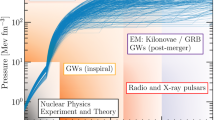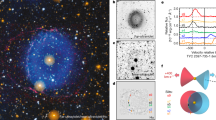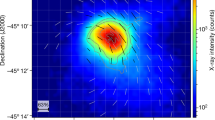Abstract
IN the course of a radio survey of bright emission nebulæ with the 1,500-ft. Sydney cross-aerial, some fourteen nebulæ were studied at a wave-length of 3.5 m. Six were probably observed in emission, seven were undetectable, and one, NGC 6357, was observed in absorption. The observation of NGC 6357 is the first reported case of absorption of radio waves by an emission nebula ; it leads to an estimate of the electron temperature of the nebula based almost entirely on radio data. In this preliminary communication the observation and its consequences are discussed briefly ; a more complete account of the survey will be given elsewhere.
This is a preview of subscription content, access via your institution
Access options
Subscribe to this journal
Receive 51 print issues and online access
$199.00 per year
only $3.90 per issue
Buy this article
- Purchase on SpringerLink
- Instant access to full article PDF
Prices may be subject to local taxes which are calculated during checkout
Similar content being viewed by others
References
Bok, B. J., Bester, M. J., and Wade, C. M., “A Catalogue of HII Regions in the Milky Way for Longitudes 250°–355°”, Harvard Report (1954).
Haddock, F. T., Mayer, C. H., and Sloanaker, R. M., Nature, 174, 176 (1954).
Author information
Authors and Affiliations
Rights and permissions
About this article
Cite this article
MILLS, B., LITTLE, A. & SHERIDAN, K. Absorption of 3.5-m. Radiation in the Optical Emission Nebula, NGC 6357. Nature 177, 178 (1956). https://doi.org/10.1038/177178a0
Issue date:
DOI: https://doi.org/10.1038/177178a0



